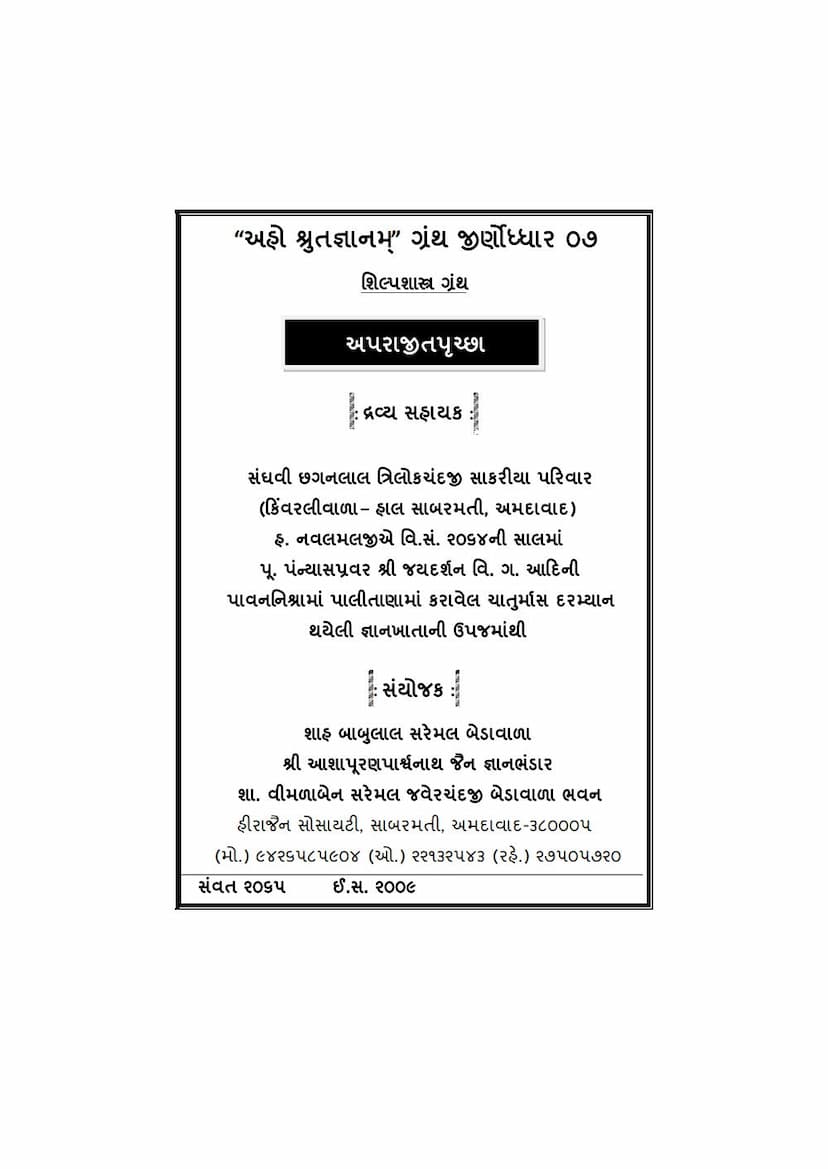Aparajitaprucchha
Added to library: September 1, 2025

Summary
This is a request for a comprehensive summary in English of the Jain text "Aparajitaprucchha." However, the provided text is a partial rendering, and the actual content is in Gujarati and Sanskrit (Devanagari script). To provide an accurate and comprehensive summary, I would need the full and correctly rendered text.
However, based on the title, author information, publisher, and the nature of Vastu Shastra texts, I can provide a general understanding of what the "Aparajitaprucchha" likely is:
Aparajitaprucchha (अ the Questionnaire of the Unconquered) is a significant ancient Indian text on Vastu Shastra, the science of architecture and environment.
Here's a breakdown of what the text likely covers, inferred from typical Vastu Shastra principles and the provided fragments:
Core Subject Matter:
- Vastu Shastra Principles: The text likely details the fundamental principles of Vastu Shastra, which aims to create harmonious and auspicious living and working spaces. This includes understanding the influence of directions, elements, and cosmic forces on built environments.
- Architecture and Construction: It would provide detailed guidelines on the design, planning, and construction of various types of buildings, including:
- Temples (Prasada): This is often a major focus in Vastu texts, covering the layout, proportions, iconography, and stylistic features of temples.
- Palaces and Royal Residences (Rajalaya): Guidance on designing grand and functional residences for rulers.
- Residential Buildings (Griha): Instructions for planning houses for different strata of society.
- Public Buildings: Possibly including assembly halls, market structures, and other civic amenities.
- Urban Planning: Guidelines for laying out entire towns and cities, including street planning, water systems, and placement of various structures.
- Iconography and Deities: Information on the placement and iconography of deities within temples and other sacred spaces, often correlating them with Vastu principles.
- Materials and Measurements: Details on the use of various building materials and the precise measurements (like Hastamāna, Talmāna) required for different architectural elements.
- Cosmic and Elemental Influences: An understanding of how celestial bodies (planets, stars), directions, and the five elements (earth, water, fire, air, ether) influence architectural design and the well-being of inhabitants.
- Stylistic Classifications: Likely discussion of different architectural styles prevalent in India, such as Nagara, Dravida, Vesara, and potentially other regional or specific sub-styles, analyzing their distinguishing features.
- Symbolism and Ritual: The text might also incorporate symbolic meanings and rituals associated with building and consecration ceremonies.
Key Features (Inferred from fragments and general Vastu knowledge):
- Question-Answer Format: The title "Prucchha" (questionnaire) suggests a dialogue format, likely between the author (Bhuvanadeva) and his sons, or a sage and disciples, posing and answering questions related to Vastu.
- Technical Terminology: Like most Vastu texts, it would employ specialized Sanskrit terms related to architecture, cosmology, and mathematics.
- Comprehensive Coverage: Vastu Shastra texts often aim for a holistic approach, covering everything from the micro-level details of architectural elements to the macro-level planning of cities.
- Authoritative Source: The text is attributed to Bhuvanadeva Acharya, suggesting it is an authoritative work based on earlier traditions.
- Geographical and Temporal Context: The introduction hints at the text's importance in understanding the evolution of Indian art and architecture, potentially placing it within a specific historical period and geographical context. The discussion on styles like Nagara and Dravida suggests it relates to the classification and understanding of regional architectural differences.
- Detailed Technical Sections: The extensive tables (like "Table No. 1-रेखा (त्रिखण्डा)") indicate highly detailed mathematical and geometrical calculations related to architectural design, possibly for creating curvilinear forms or specific proportions of structures. The detailed breakdown of "Rekha" (profiles of spires) suggests intricate design principles.
To provide a more specific summary, the following would be helpful:
- Complete Text: Access to the entire text, accurately transcribed and translated, would be ideal.
- Specific Chapters/Sections: If you can identify particular sections or chapters that are of primary interest, a more focused summary can be provided.
- Key Themes: Are you interested in the text's approach to temple architecture, residential buildings, specific design elements, or its philosophical underpinnings of Vastu?
In summary, the "Aparajitaprucchha" is a foundational text in Vastu Shastra, offering extensive knowledge on the principles and practices of ancient Indian architectural science. It likely covers a wide range of topics from the macro-level design of settlements to the micro-level details of architectural components, all within the framework of cosmic harmony and auspiciousness.